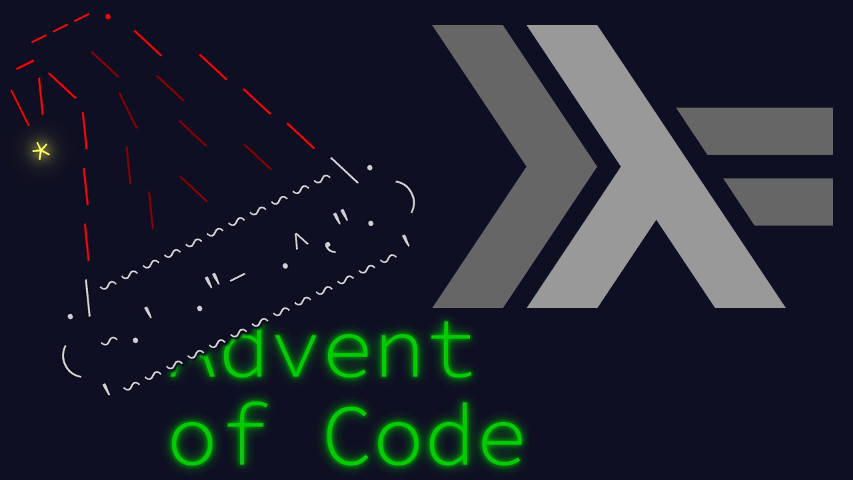Yesterday wasn’t number theory, but today’s Advent of Code puzzle, “Restroom Redoubt”, kind of is. If you squint. And insist. Let’s start, with a few imports to make this post a valid literate Haskell program too.
import Control.Arrow ((&&&),(>>>))
import Data.Char (isDigit)
import Data.Function (fix)
import Data.List (genericTake,group,sort)
import Data.Proxy (Proxy(Proxy))
import Math.NumberTheory.Moduli (Mod,SomeMod,chineseSomeMod,modulo)
import GHC.TypeNats (KnownNat,natVal)So the general idea is we have a bunch of robots evolving on a 2D grid. What makes this somewhat number-theoretical is their teleportation feature, which is a convoluted way of saying their grid is topologically a torus, wrapping horizontally and vertically. The grid dimensions are, conveniently, prime. Let’s define a specialized vector type for it.
data V = V
{ _x :: !(Mod 101)
, _y :: !(Mod 103)
}V2 from the linear package resists being
parameterized with different types for its dimensions, so I’ll need to
scaffold up the few operations I’ll be using.1
instance Num V where V x1 y1 + V x2 y2 = V (x1+x2) (y1+y2)
(*^) :: Int -> V -> V
λ *^ (V x y) = V (fromIntegral λ*x) (fromIntegral λ*y)Our robots are characterized by a position and a velocity, both appropriately vectors in this space.
data Robot = Robot
{ _pos :: !V
, _vel :: !V
}Parsing is arguably the most complicated part of this problem, as today we do get negatives. Today I’ll enforce a bit of the input’s structure.2
parse :: String -> [Robot]
parse = map line . lines where
line l = Robot (V px py) (V vx vy) where
(px,l') = readInt (drop 2 l)
(py,l'') = readInt (drop 1 l')
(vx,l''') = readInt (drop 3 l'')
(vy,[]) = readInt (drop 1 l''')
readInt s =
let (n,s') = break (not . ((||) <$> isDigit <*> (== '-'))) s
in (read n,s')Our robots know one main operation: advancing in the direction of their velocity vector. Let’s define an operation to advance them by a certain number of seconds.
advance :: Int -> Robot -> Robot
advance i (Robot pos vel) = Robot (pos + i *^ vel) velIn part 1, we’re asked to advance them by 100 seconds, then compute some form of checksum on their final positions.
part1 :: [Robot] -> Int
part1 = safetyFactor . map (_pos . advance 100) whereAdvancing was trivial, but we still need to checksum.
safetyFactor :: [V] -> Int
safetyFactor =
product . map length . group . sort . filter noEQ . map quadrant
where quadrant (V x y) = (compare x 50,compare y 51)
noEQ (x,y) = x /= EQ && y /= EQDismissing the crosshairs is mildly annoying, but doable. So then we’re done for part 1.
In part 2, arguably the most controversial of the year, we’re asked to recognize a christmas tree formed by the robots at a specific moment in time.
Running for stars, you’re mostly doing it visually, guided by various external knowledge. Some people had luck minimizing the safety factor, but it wasn’t exactly a slamdunk with my input.3 That doesn’t make a good solution post, so let’s implement something reasonable, yet direct.
The main observations for this type of puzzle are:
- axes wrap, so the robots’ projection on those axes loop.
- the axes’ dimensions are prime4, so the loop period is exactly that prime and not something smaller.
- the axes’ dimensions are coprime, so the full set loops by their product.
If the product was actually large, we’d want to detect some form of “interestingness” per axis, then deduce the peak interestingness across all axes using the chinese remainder theorem. In this case, 101 × 103 = 10403 which isn’t high enough to not do both at once, but no matter, let’s implement the smart stuff anyway for demonstration purposes.
We still need to find some definition of interestingness. The reddit thread has a lot of people using the statistical standard deviation, but this kind of5 presupposes to know the shape of the solution before having seen it, which isn’t the most senseful thing ever. I’ll use the other common approach, measuring entropy.
Let’s start with the wrapper, for once. Reading top to bottom, with a list of robots as input.
part2 :: [Robot] -> Maybe SomeMod
part2 =
iterate (map (advance 1)) >>>
(map . map) _pos >>>
(minEntropyOffset _x &&& minEntropyOffset _y) >>>
uncurry chineseSomeModGenerate an infinite list of robot sets, keeping only the positions, then extract the offset (the index from the start) of the minimal entropy found when projected to that axis, then combine both axes using the chinese remainder theorem.
Let’s compute the minimal entropy offset now. This is likely my niftiest function of the year. What’s so cool about it? Apart from the “extractor”, i.e. the projection function, all it takes is a list of vector sets. It most notably doesn’t need the modulo/cycle length/alphabet size: it takes it from the types at compile time. I love it.
minEntropyOffset :: forall m. KnownNat m => (V -> Mod m) -> [[V]] -> SomeMod
minEntropyOffset proj =It uses 3 internal terms: the modulus m—a compile-time constant—, the probability extracting function, and the entropy computing function. Note that last one doesn’t bother using the appropriate logarithm base: as we’re only comparing those entropies with each other, that base is only a scaling factor that doesn’t influence ordering.
let m = natVal (Proxy @m)
prob xs = fromIntegral (length xs) / fromIntegral m
entropy p = -p * log pNow we can process. Top to bottom: for each set, project to the
relevant axis, sort and group by resulting coordinate; for each distinct
coordinate compute its entropy through probability; infer global entropy
by summing. Take the first m
resulting set entropies, the rest being expected to cycle. Extract the
index of the smallest one; then convert to a generic
SomeMod value so the library’s CRT can operate on simple
values.
in
map (sum . map (entropy . prob) . group . sort . map proj) >>>
genericTake m >>>
minIndex >>>
flip modulo mWe need a minor helper to extract the index of the smallest. Nothing fancy, just recursive pattern matching.
minIndex :: Ord a => [a] -> Integer
minIndex (x0:xs0) = flip fix (x0,0,1,xs0) $ \go -> \case
(m,mi,i,x:xs) | x < m -> go (x, i,i+1,xs)
| otherwise -> go (m,mi,i+1,xs)
(_,mi,_,[]) -> miAdding a main wrapper, suspiciously similar to the rest
of the year’s.
main :: IO ()
main = interact $ show . (part1 &&& part2) . parseAnd we’re done.
Ok, that was really artificial. But it was pleasant Haskelling, ought to work for most inputs, and nice code.
See you tomorrow!
Yes, that
Numinstance is very incomplete. Doesn’t hinder the day.↩︎As opposed to yesterday. For no better reason than variety.↩︎
In my case, I ended using the “not too many overlapping robots” heuristic, which wasn’t exactly perfect either: a few ealier timestamps shared that property.↩︎
…and at least one velocity is non-null on that axis.↩︎
Kind of. It is fairly reasonable, as far as AoC goes.↩︎



